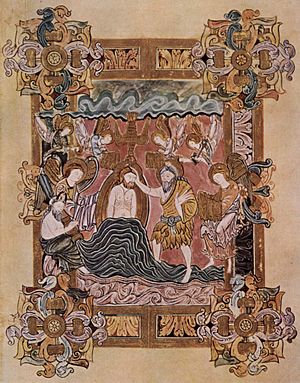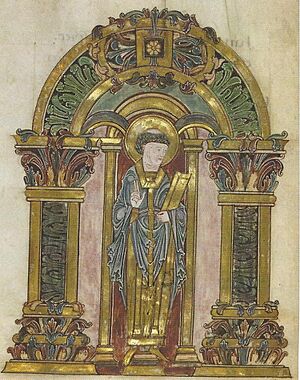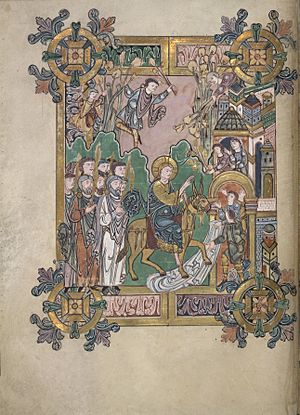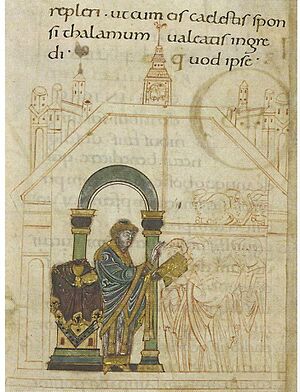Benedictional of St Æthelwold facts for kids


The Benedictional of St Æthelwold is a very old and beautiful book from the 10th century. It is a special type of book called an illuminated manuscript, which means it has amazing pictures and decorations drawn by hand. This book is considered one of the most important artworks from the Anglo-Saxon period in England.
A benedictional contains special blessings that a bishop would say during church services, especially during Mass. These blessings changed depending on the day of the year or the saint being celebrated. This book also includes a blessing for the candles used during the Feast of the Purification. A monk named Godeman wrote this book for Æthelwold, who was the Bishop of Winchester at the time.
The book is incredibly decorated and is seen as a masterpiece of Anglo-Saxon art. It has 28 full-page pictures and many other decorated pages. The artists used a wide range of bright colors, along with lots of gold and silver. The pictures are known for their brilliant colors and lively decorations, often featuring a leafy design called acanthus.
You can see influences from other European art styles in the book. For example, the elegant writing style and some paintings show ideas from the Carolingian period in France. However, the book also has a strong English feel, with its exciting mix of colors and lines, and the way figures seem to float easily across the pages.
Contents
History of the Benedictional
When Was the Book Made?
The Benedictional was created sometime between the years 963 and 984. Most experts believe it was made during the 970s. Inside the book, there is a Latin message that explains how it came to be.
The message says:
A bishop, the great Æthelwold, whom the Lord had made patron of Winchester, ordered a certain monk subject to him to write the present book . . . He commanded also to be made in this book many frames well adorned and filled with various figures decorated with many beautiful colours and with gold. This book the Boanerges aforesaid caused to be indited for himself . . . Let all who look upon this book pray always that after the term of the flesh I may abide in heaven Û Godeman the scribe, as a suppliant, earnestly asks this
Æthelwold was the Bishop of Winchester from November 29, 963, until he died on August 1, 984. So, the book must have been made between these dates. One of the blessings in the book mentions miracles performed by St. Swithun. This suggests the blessing was written after 971, when Swithun's holy remains were moved. Also, another saint, Ætheldreda, is given special importance in the book. This likely means the book was made after 970, when Æthelwold helped restart the abbey at Ely, which Ætheldreda had founded.
Who Was Godeman?
The monk who wrote the book, Godeman, worked at the Old Minster in Winchester. He might have been part of a group of monks that Æthelwold brought from Abingdon to Winchester. In 973, Æthelwold sent Godeman to a new monastery at Thorney. Godeman continued to be the abbot (leader of the monastery) of Thorney even after Æthelwold died. Some records say that Godeman was Æthelwold's personal chaplain, meaning he helped Æthelwold with religious duties.
Where Has the Book Been?
It is thought that the Benedictional stayed in Winchester after Æthelwold's death. Later, in the 15th century, its binding was strengthened with a list of holy items from Hyde Abbey. This suggests the book might have been at Hyde Abbey for some time during the Middle Ages.
In the 17th century, the book was owned by Henry Compton, who was a bishop. After Bishop Compton died in 1713, the book went to his nephew, Gen. Hatton Compton. General Compton then gave the book to William Cavendish, 2nd Duke of Devonshire. Eventually, the British Library bought the book from the Duke's family, and it is now kept there.
What the Text Contains
The Latin text in the Benedictional holds the blessings that a bishop would read during Mass. Each day in the church calendar and each saint's special day had a different blessing. This book includes blessings for three local saints: St. Vedast, St. Ætheldreda, and St. Swithun. These blessings would not have been found in a benedictional from other areas.
The text seems to be a mix of different older church texts. It combines parts from a "Gregorian" benedictional, which came from a Roman prayer book, and an 8th-century text from the Gallican Rite (an old French church tradition). The book also contains several blessings that were written specifically in Winchester.
A similar mixed text is found in another book called the Ramsey Benedictional. Some believe Godeman might have written that book too. It's not certain which book was made first. However, this unique mix of texts became very important and influenced other church books in England and France during the 10th and 11th centuries.
Amazing Illustrations
The Benedictional is famous for its beautiful pictures. One special picture on page 102v shows the Feast of the Assumption. This image shows the death of the Virgin Mary and her being crowned in heaven. This might be the first time this scene was shown in Western art.



